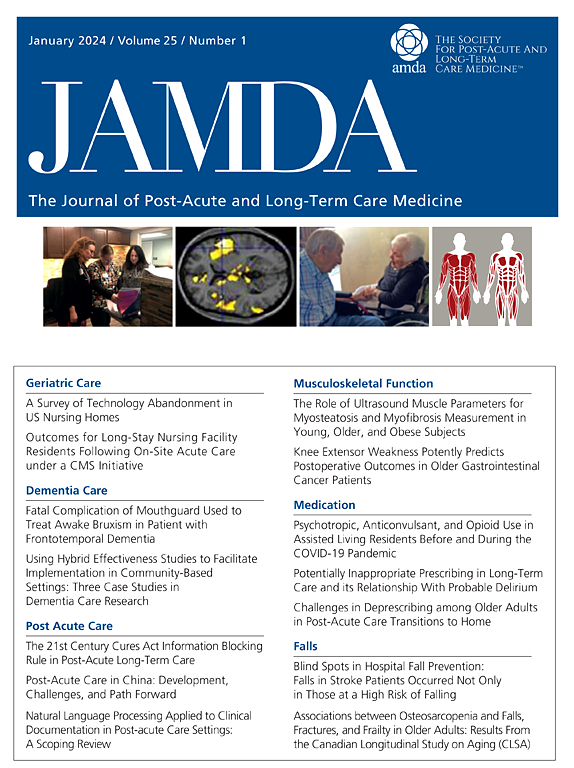Polypharmacy and Mild Cognitive Impairment in Older Adults: A 3-year Study of DO-HEALTH
IF 4.2
2区 医学
Q2 GERIATRICS & GERONTOLOGY
Journal of the American Medical Directors Association
Pub Date : 2025-04-19
DOI:10.1016/j.jamda.2025.105586
引用次数: 0
Abstract
Objective
To examine the association between polypharmacy and mild cognitive impairment (MCI) at baseline and over 3 years in community-dwelling older adults.
Design
Observational analysis of the DO-HEALTH trial.
Setting and Participants
Community-dwelling adults aged ≥70 years with good cognitive function and without major diseases at baseline.
Methods
Main exposure was polypharmacy at baseline (≥5 medications). The outcome was MCI (Montreal Cognitive Assessment [MoCA] score <26), assessed at baseline and years 1, 2, and 3. Logistic regression and generalized estimating equations (GEEs) for repeated binary outcomes were used for the cross-sectional and longitudinal analysis, respectively. Minimally adjusted models included age, sex, prior fall, study site, body mass index, and education. Fully adjusted models additionally adjusted for mental health and multimorbidity. GEE models also accounted for time and DO-HEALTH treatment effects. Sensitivity analysis used a stricter MCI definition (MoCA < 24).
Results
A total of 2153 participants completed MoCA at baseline. Baseline MCI prevalence was higher in participants with polypharmacy compared with those with no polypharmacy (MCI < 26: 53.5% vs 46.5%; MCI < 24: 34.9% vs 17.2%). Polypharmacy was associated with greater MCI odds at baseline in the minimally adjusted models (MoCA < 26: odds ratio [OR], 1.32; 95% CI, 1.05–1.66; MoCA < 24: OR, 1.37; 95% CI, 1.06–1.79). Over 3 years, polypharmacy was associated with increased MCI odds in the minimally adjusted models (MoCA < 26: OR, 1.28; 95% CI, 1.08–1.52; MoCA < 24: OR, 1.33; 95% CI, 1.07–1.65). Notably, these associations were somewhat attenuated and nonsignificant after controlling for mental health and multimorbidity.
Conclusion and Implications
Our findings suggest that MCI is more prevalent in older adults with polypharmacy compared with those without polypharmacy. Although polypharmacy was associated with MCI at baseline and over 3 years, these associations were attenuated by mental health and multimorbidity, suggesting that mental health and multimorbidity contribute to both polypharmacy and MCI.
多药治疗与老年人轻度认知障碍:一项为期3年的DO-HEALTH研究。
目的:探讨复方药物与社区老年人基线及3年以上轻度认知障碍(MCI)之间的关系。设计:DO-HEALTH试验的观察性分析。环境和参与者:≥70岁、认知功能良好、基线时无重大疾病的社区居住成年人。方法:基线时主要暴露于多种药物(≥5种药物)。结果是MCI(蒙特利尔认知评估[MoCA]评分)结果:共有2153名参与者在基线时完成了MoCA。与未服用多种药物的受试者相比,服用多种药物的受试者MCI的基线患病率更高(MCI < 26: 53.5% vs 46.5%;MCI < 24: 34.9% vs 17.2%)。在最低调整模型中,多药与基线时较高的MCI几率相关(MoCA < 26:比值比[OR], 1.32;95% ci, 1.05-1.66;MoCA < 24: OR, 1.37;95% ci, 1.06-1.79)。3年后,在最低调整模型中,多药与MCI几率增加相关(MoCA < 26: OR, 1.28;95% ci, 1.08-1.52;MoCA < 24: OR, 1.33;95% ci, 1.07-1.65)。值得注意的是,在控制了心理健康和多重疾病后,这些关联有所减弱且不显著。结论和意义:我们的研究结果表明,与没有服用多种药物的老年人相比,服用多种药物的老年人MCI更为普遍。尽管在基线和超过3年的时间里,多重用药与轻度认知损伤相关,但这些关联被精神健康和多重疾病减弱,这表明精神健康和多重疾病对多重用药和轻度认知损伤都有贡献。
本文章由计算机程序翻译,如有差异,请以英文原文为准。
求助全文
约1分钟内获得全文
求助全文
来源期刊
CiteScore
11.10
自引率
6.60%
发文量
472
审稿时长
44 days
期刊介绍:
JAMDA, the official journal of AMDA - The Society for Post-Acute and Long-Term Care Medicine, is a leading peer-reviewed publication that offers practical information and research geared towards healthcare professionals in the post-acute and long-term care fields. It is also a valuable resource for policy-makers, organizational leaders, educators, and advocates.
The journal provides essential information for various healthcare professionals such as medical directors, attending physicians, nurses, consultant pharmacists, geriatric psychiatrists, nurse practitioners, physician assistants, physical and occupational therapists, social workers, and others involved in providing, overseeing, and promoting quality

 求助内容:
求助内容: 应助结果提醒方式:
应助结果提醒方式:


